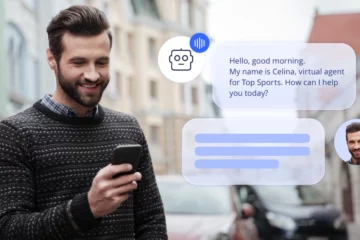Conversational bots are tools many of us have interacted with personally (perhaps without even realizing it), but they are still in early stages of advanced usage in businesses. This is mainly due to a lack of understanding and the perception that their implementation can be complex. However, as companies explore and better understand the potential of conversational AI, they will realize their numerous benefits and strategic opportunities they offer.
To address some doubts regarding conversational bots, we will now answer the 10 most frequently asked questions about bot implementation.
Question 1: What determines the intelligence of a chatbot?
A chatbot’s intelligence is determined by several factors that influence its ability to effectively understand, process, and respond to interactions with users. One of these key factors is whether it is powered by AI.
If the bot is equipped with conversational AI, the quality of its training and the breadth of topics it has been exposed to will determine how intelligent it is. In other words, if the bot receives continuous training and improved content we ensure that it is both intelligent and useful by offering customers rich and accurate responses to what they initially searched for.
Question 2: How to define the conversation and customer journey flows for the bot?
It is essential to identify the most common interaction scenarios with the bot. This involves mapping the possible paths a conversation can take, anticipating typical queries and appropriate responses.
Furthermore, understanding the customer journey involves knowing the key touch points in the user experience, from the first interaction to the conclusion of the transaction or query. By aligning conversation flows with the customer journey, a coherent and efficient experience is ensured that meets the user’s and the company’s goals.
Question 3: What sources of information will the chatbot use?
For a chatbot to function properly, it is essential that it has access to company data, whether from your existing knowledge base, website, internal databases, existing documents, CRM, product inventories, or other sources of information.
Technology such as Machine Learning will allow the bot to have the ability to adapt to unforeseen scenarios and unsaved information, and to handle unexpected situations with useful and relevant responses. Crucial to this is that you can collect data on user interactions to continually iterate and improve conversation flows.
Question 4: What is the expected timeline for a bot implementation?
In general terms, the process can be divided into five stages: planning, design, development, testing, and deployment. The planning phase involves defining objectives, identifying use cases, and creating a detailed plan. Design focuses on creating conversation flows, user interface, and integration with existing systems.
Development encompasses the implementation of the bot and programming its functionalities, while testing ensures its correct operation and detects possible issues. Finally, deployment completes the process, bringing the chatbot to the platform where it will be available for users. The total duration can vary dfrom weeks to months, depending on the scale and complexity of the project.
Question 5: Are chatbots multilingual?
Yes, a bot can be trained to respond in different languages. This involves incorporating natural language processing (NLP) capabilities that allow the bot to understand not only the words in different languages, but also understand the context and linguistic subtleties associated such as regionalisms.
A bot’s multilingual capability can be especially beneficial in global environments, facilitating effective communication with diverse audiences.

Question 6: When will the bot transfer the conversation to a human agent?
There are going to be different scenarios where a bot has to transfer the contact to a human agent. The main scenario is if the client requests it. It could also happen if the same question is asked several times and the bot does not know how to answer. This may be due to the complexity of the problem, lack of information in the knowledge base, or situations where a human touch is required, such as emotional cases or complicated transactions.
The important thing is to ensure a frictionless transition for high-quality service and customer experience.
Question 7: What are the functions of a bot?
Chatbots can perform a variety of tasks, from answering frequently asked questions to automating everyday processes, collecting customer information through conversational forms, selling, managing lead management, and more.
The functions of the bot will depend on the specifics and business needs, as well as the main purpose for which the chatbot will be intended.
Question 8: Can a bot handle multiple user conversations?
Of course! That is one of the great advantages of chatbots: responding simultaneously to multiple users in real time.
The ability to handle simultaneous conversations is particularly valuable in customer service and online service environments, where volume is high and users may request to interact at different times and on a variety of topics.
Question 9: How scalable is a bot solution?
A well-designed chatbot solution can handle a significant increase in the number of users and queries without compromising performance. Scalability is also tied to the ability to improve and expand the bot’s functionality over time. Solutions like inConcert’s Conversational bot, allows easy integration of new features and rapid adaptation to changes in business requirements and scenarios.
Question 10: Can a chatbot be integrated with existing systems, such as a CRM or other contact platforms?
Yes, omnichannel chatbots have the ability to connect to other tools. There are 360° solutions that, by belonging to the same ecosystem, already connect the bot with the CRM or marketing automation platform natively.
Integrating the bot with other systems, for example the Contact Center, will allow a fluid bot-agent transfer, with a history of interactions and will give the human touch to this technology, improving the customer experience.
If you still have questions or want to explore the specific use case of a chatbot in your business, contact one of our executives.



